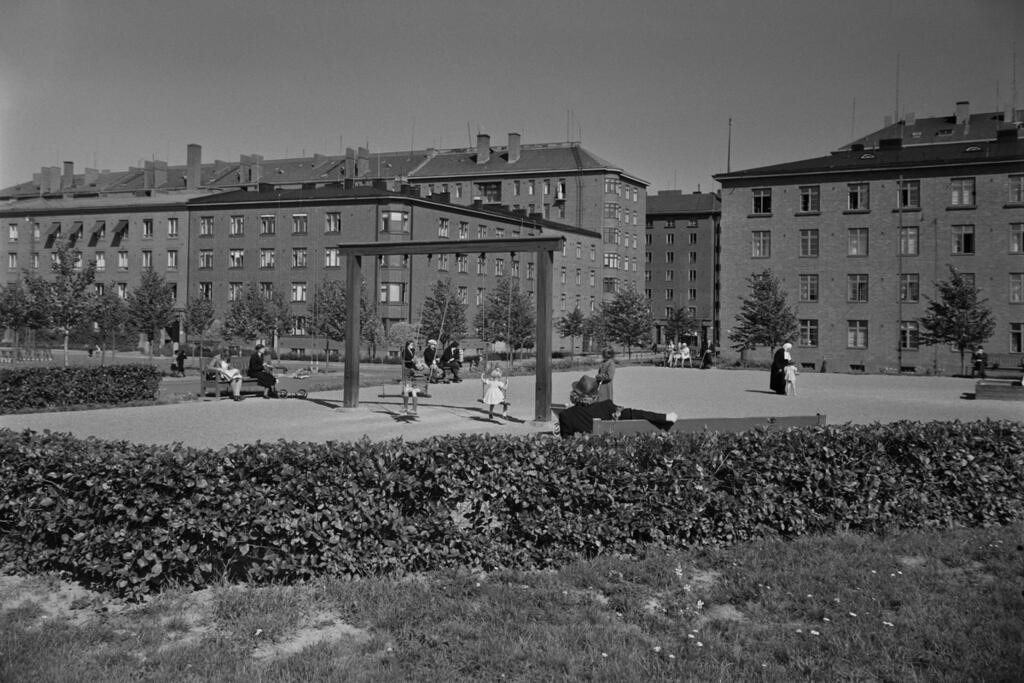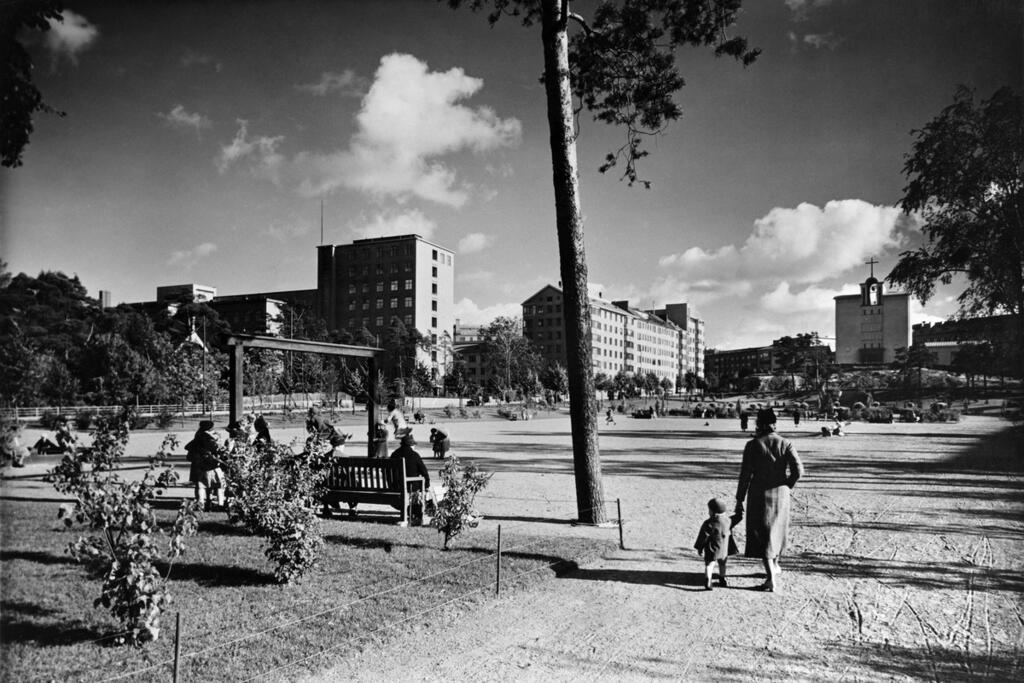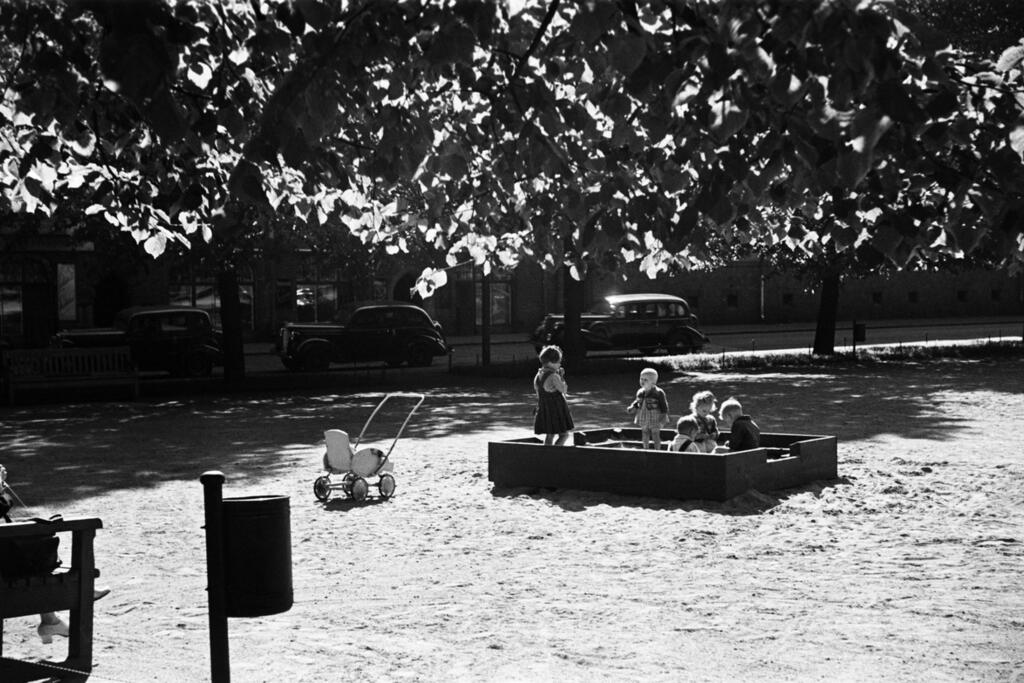
Play becomes part of parks
Helsinki grew rapidly in the second half of the 19th and early 20th centuries. The city centre transformed into stone structures, and the wooden suburbs expanded. As the forests retreated further, parks became civilised substitutes for nature, wellsprings of peace and beauty, and sources of mental and physical health. They reflected the ideals of the leading cultural and economic elite. People visited the parks – such as the ones on the Esplanade and Kaivopuisto – for leisurely walks along the promenade, enjoying the landscapes, gardens, and elegant upper-class socialising. Running, shouting, games and playing were not appropriate in these parks, not to mention sitting around on the lawn and eating snacks.
The social and health problems of a growing Helsinki came to a head in the densely populated working-class districts behind Punavuori and Pitkänsilta, which had no parks. The city’s elite became aware of the difficult living conditions faced by the working classes and, in the spirit of philanthropy, began to alleviate the problems caused by these conditions. Separate parks for the working classes were established in Korkeasaari in 1883 and Seurasaari in 1889. The public parks, which were more relaxed than the upper-class parks, were almost in a natural state, where it was hoped that nature and fresh air would refresh those exhausted by work and ward off illness and drunkenness.
Spaces for children to play in dwindled as the city grew. As stone houses went up, yards became confined and dark, and as traffic increased, playing in the streets became dangerous. There were plenty of undeveloped areas in Helsinki, but as sports became more popular, there was a need for proper sports fields. As early as the 1870s and '80s, people were already complaining about there being insufficient space for schoolchildren to play ballgames. The clearing of a sports field in Kaisaniemi in 1886 sparked controversy, as many felt it would ruin the park. There were no designated places for small children to play, and on the sports fields, the little kids were in the way of older children.
At the turn of the century, there was a heightened awareness of social injustices and concerns about the class conflict they caused. People wanted to tackle these problems in various ways. Children and the working class were seen as particularly important target groups whose well-being was to be improved and whose commitment to society was to be reinforced. At the same time, new professional groups emerged, such as architects specialising in urban planning and a wide range of education professionals who wanted to contribute to solving society’s problems. Play and parks played an important role in this.
In 1898, an initiative for increasing the number of playgrounds was presented to the City Council. The very next year, playgrounds opened in Kaivopuisto and Kaisaniemi, and sledging hills were built in the parks. Playgrounds were also built in other parks, but they were small and awkwardly placed because, according to the city gardener, playing endangered the plants and did not fit in well with the architecture of the parks.
Many children were born in Helsinki in the early decades of the 20th century, and their needs, including play, became a topic of discussion. In 1913, the Finnish Gymnastics Teachers’ Association wrote to the City Council criticising the smallness, scarcity and poor quality of the playgrounds in Helsinki compared to those in civilised countries. The gymnastics teachers demanded that their expertise be taken into account in the design of the playgrounds and called for the introduction of guided play activities. The importance of exercise, light and fresh air was justified by the prevalence of tuberculosis among children and the poor health of primary school children.
The city’s town-planning architect, who took the lead in park design, looked into the playground issue in 1914 and acknowledged that the criticisms were justified. Impressed by what had been achieved with playgrounds abroad, especially in the United States, he believed that parks in Helsinki should also be dedicated to sports. Instead of simply being places for admiring the scenery, parks needed to provide an active and rational form of recreation. Instead of flowers, sculptures and other unnecessary things, parks were to have playgrounds and sports fields appropriate for all ages.
Guided play, which the gymnastics teachers had proposed, was popular in the United States because it was an effective way to get large groups of children to exercise. Play and physical activity had to be supervised to ensure the desired physical and moral effects. Order and discipline were needed to counterbalance the chaos of free play and prepare children for society. In the United States, statistics were used to show that playgrounds prevent juvenile delinquency and save on hospital and prison costs, which was also argued in Helsinki.
These arguments convinced the City Council, which accepted the offer from the gymnastics teachers and approved the funds to start guided play in the summer of 1914. For three months, twelve play instructors toured the playgrounds of Kapteeninpuistikko, Kallio Primary School, the Lapinlahdenkatu park and the small field in Kaisaniemi. The enthusiasm of the children and the satisfaction of the parents were already so high in the first summer that the Council established permanent funding for the play activities run by the gymnastics team.

Summer games in modest spaces
Playgrounds and guided play became established in Helsinki in the 1920s and 1930s, but were not systematically developed. The birth rate levelled off, and the needs of young children took a back seat as schools were hastily built for the large age cohorts born in the early twentieth century. The main focus of sports infrastructure was on competitive sports for adults, in which the young republic was hungry for success. Playgrounds were built in parks, but they were often just rectangular lots of sand, with the occasional sandbox and a swing or two. Of course, many other venues also offered summer recreation for children, including numerous associations and organisations that ran summer camps and organised outings and other activities for children.
Playground activities were also seeking their place within the city’s administration. In 1917, the Education Committee was tasked with their supervision, followed a few years later by the Child Welfare Centre, and in 1923, by the Child Welfare Committee. The link to child welfare obscured the fact that guided play was intended to be a summer pastime for all children, regardless of their background. Some parents saw the playgrounds as charity for the poor, while others complained that only the wealthiest and most enlightened working-class families knew how to take advantage of the service.
Nevertheless, the children who found their way to the playgrounds were a very diverse group, and there was no shortage of diversity in the traditionally multicultural Helsinki. The only surviving statistics show that in the summer of 1934, children spoke the following languages at the Hietaranta playground: Finnish, 762; Swedish, 102; Estonian, 3; German, 2; English, 2; French, 1; Polish, 1; Turkish, 5; and Russian, 3. It was also mentioned that 11 of the children were Jewish. The wide age range and diverse social background of the participants are reflected in the following figures: 529 primary school pupils, 125 grammar school pupils, 17 in preparatory school, 46 in nursery school, 7 in vocational school, 16 in secondary school, 7 in auxiliary school and 154 at home. The instructors were taught to treat the children equally and fairly, so the children’s background was not allowed to influence play or games.
Each playground usually had three instructors, or ‘ladies’, who were initially mainly gymnasts and, without exception, women – the playgrounds were the birthplace of a new female profession. Later on, new instructors also emerged from among the children who played there. Teenagers were employed as ‘little ladies’ during the summer, some of whom stayed in the profession with various educational backgrounds. The work of a play instructor was learned in practice from older colleagues, and gradually, that knowledge was condensed into written rules. Courses did not start until 1945, and with year-round playground activities in the 1950s, the instructors began to develop their skills, including holding work evenings where they learned new games, songs and crafts. The content of playground activities depended largely on the enthusiasm and creativity of the ladies, who came up with fun activities, parties and outings.
In the 1920s and 1930s, summer games were held on four playgrounds in different parts of the city. The Eläintarha (zoo) and Vallila playgrounds were well-established, as was the Hietaranta playground on the beach, which was created in 1929. Children in southern Helsinki played alternately in Kaivopuisto, Kapteeninpuistikko, Sepänpuisto or Vuorimiehenpuistikko parks. The facilities were modest. It was not until 1933 that outhouses were installed in Eläintarha, Hietaranta and Vallila, and in 1935, Hietaranta even got a water supply. None of the playgrounds had indoor facilities, so the instructors carried their minimal play equipment with them, unless they were able to store them in some basement near the park.
The range of playground equipment was recorded during the summer of 1925 at the Eläintarha playground. At the end of the day, the toy box contained five line balls, seven shovels for the sandbox, four moulds, 11 small balls, eight sets of reins, three ball nets, three dolls, a counting game, a Black Peter game, a card game, a bag of peas, a car, a doll stroller, a wooden ball game, and nine bowling pins. That summer, 407 children were registered at the playground, and there could be 200 children playing at the same time. What became playground classics were stilts and boys’ carts, the first of which were bought from Stockmann in 1935 for the Eläintarha playground. Developing and maintaining play equipment was the responsibility of the instructors.
Even during wartime, children continued to play in Helsinki’s playgrounds, even as the number of children in the city dwindled. Children were sent to the countryside for safety and to Sweden and Denmark as refugees, known in Finland as ‘war children’ (sotalapset). In 1941, the Continuation War interrupted the games by Midsummer, but in 1942, the games continued as before, as they did in the following summers.
In the summer of 1942, food distribution began in Helsinki’s playgrounds, a tradition that still continues despite much controversy. By 1938, the Council had already granted funds for picnic lunches, but regular park meals began with the aim of strengthening the children who were going hungry due to food shortages. The city’s food centre delivered large tubs of pea soup, meat soup, or gruel, which the children could eat as much of as they wanted.

From children’s playgrounds to playgrounds for everyone
After the war, the focus shifted to the future. Population growth was encouraged, and birth rates peaked as the baby boomer generation was born. The aim was to allow children to grow up in an environment that reflected the ideals of the new age. At the same time, Helsinki expanded dramatically in a major regional merger in 1946. A new type of housing began to be built in the incorporated areas: apartment blocks placed sparsely in the middle of nature, which were designed as large complexes with services.
In this atmosphere, interest in playgrounds was rekindled. The city set up a committee to look into improving playgrounds. Completed in 1950, its report set the goals high. A first-class playground had to be a fenced area of at least one hectare, part of which was to be designated as a playground for older children and another part as a playground for small children. There was to be a building on the site for the instructor, for the children to warm up in and for storing equipment. In addition, there needed to be a wading pool, areas for building things and playing house, swings, a carousel, a slide, a water supply, a toilet and, in winter, an ice-skating rink, a cross-country skiing track and a sledging hill.
The administrative status of playgrounds became permanent in 1951, when they were finally incorporated into municipalities. The playground activities were placed under the supervision of the Nursery School Board, and a dedicated playground inspector was appointed. Playgrounds began to develop rapidly. By 1948, the portables discarded from the ice-skating rinks were finally installed as equipment storage at the Eläintarha, Kaivopuisto and Pirkkola playgrounds. In 1951, the long-awaited year-round playground activities began at Brahe Field, and soon, cabins were provided to shelter the children.
The number of playgrounds increased, and many new playgrounds were built to be in use year-round from the outset. Year-round playgrounds were built in new residential areas and suburbs on the outskirts of the city, such as Käpylä in 1952, Toukola in 1954, Maunula in 1954, Tullinpuomi in 1957 and Pohjois-Haaga in 1959, as well as in city centre areas lacking playground space, such as Vallila in 1955 and Sepänpuisto in 1956. The pace of building was still regarded as slow, and in 1956, a new playground committee called for a total of 128 playgrounds to be built. In 1962, the next committee repeated this call as birth rates continued to rise.
As suburban development accelerated in the 1960s, large construction companies used prefabricated materials to produce entire neighbourhoods, and economic considerations dictated the constraints. Children’s needs were easily overshadowed by economic ones, and playgrounds were often built later and sometimes in remote and difficult-to-access locations. Sometimes, the playground inspector virtually had to personally step in and seize space for playing from the scarce green spaces in the suburbs. In the public debate of the age of awareness, the city was accused of being hostile to children. Still, well-equipped playgrounds opened almost every year in the suburbs of East Helsinki in the 1960s, areas largely populated by vast numbers of children, and the profession and field of play instructors grew steadily.
As women’s employment became more common, the need for daycare increased, and daycare became a statutory social service in 1973. Helsinki’s playgrounds continued to operate as its complement. The construction of playgrounds intensified, but the nature of their activities changed. In 1981, the term ‘playground’, which evoked the disciplined and orderly roots of guided play and the sharp whistles of playground ladies, was abandoned in favour of ‘play park’. The post of playground inspector was eliminated in 1985, and playgrounds were decentralised to the various daycare offices in the large districts, which weakened their previously close-knit relationship.
In 1991, the summer playgrounds were closed down, having become outdated. The clientele and range of activities expanded in the year-round play parks and their former spontaneity was replaced by more regular activities. After-school activities for schoolchildren began to gain in importance from the 1980s onwards, and by the 1990s, play parks were already starting to be seen as a meeting place for the entire neighbourhood, where everyone from babies to grandparents was welcome. As Helsinki’s ethnic and cultural diversity has grown, it has brought both new opportunities and new challenges.
Today, Helsinki has a city-wide network of 60 year-round play parks, offering a wide variety of services to its diverse residents of all ages. The play parks, which are open to all, free of charge, and professionally run, are a distinct Helsinki phenomenon in their extent. They are the result of almost a hundred years of ambitious development efforts.
Text: Jere Jäppinen
Text is originally published in On meillä nasta täti - leikkikenttien vanhoja laululeikkejä(Link leads to external service) -publication.